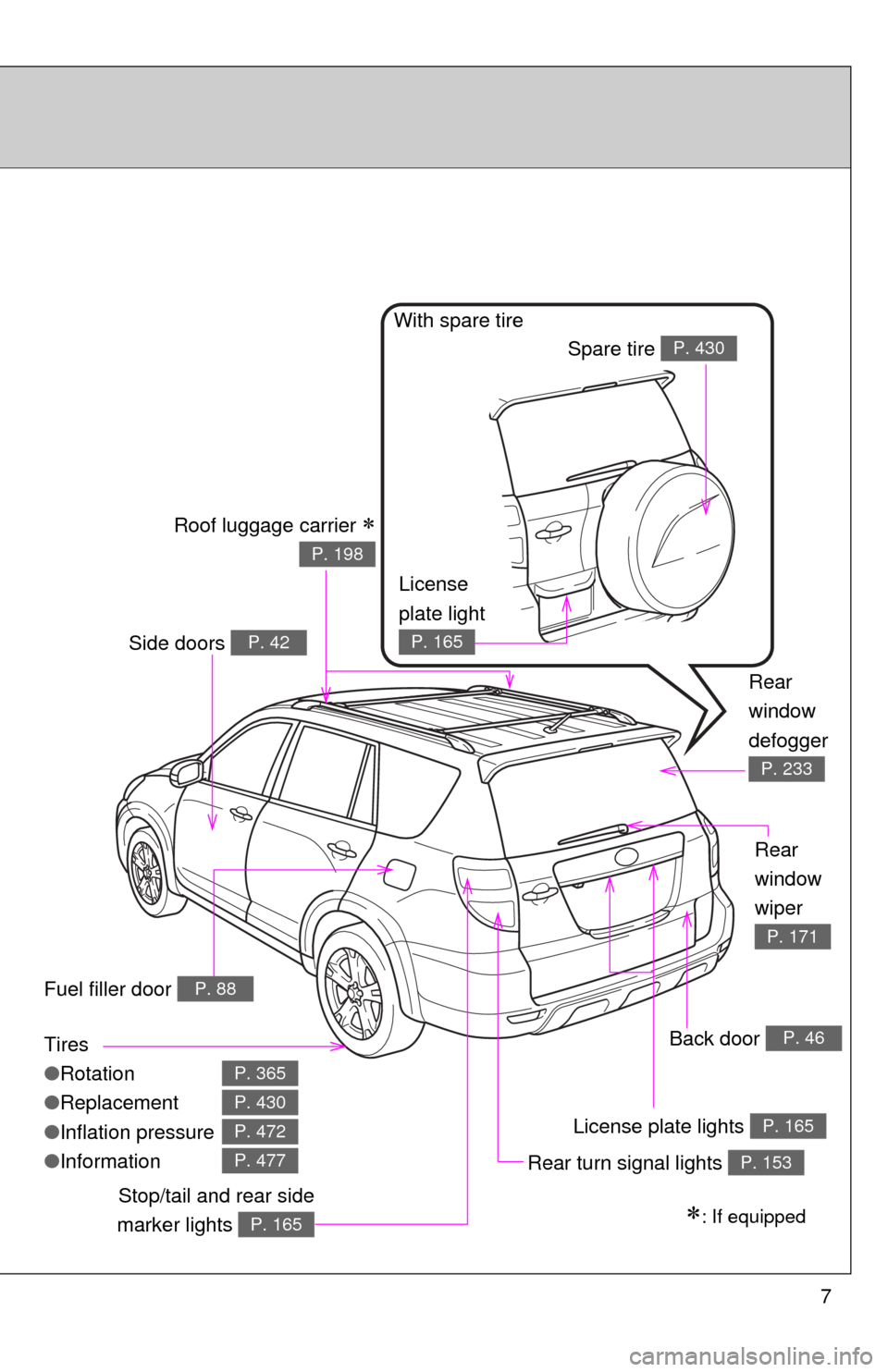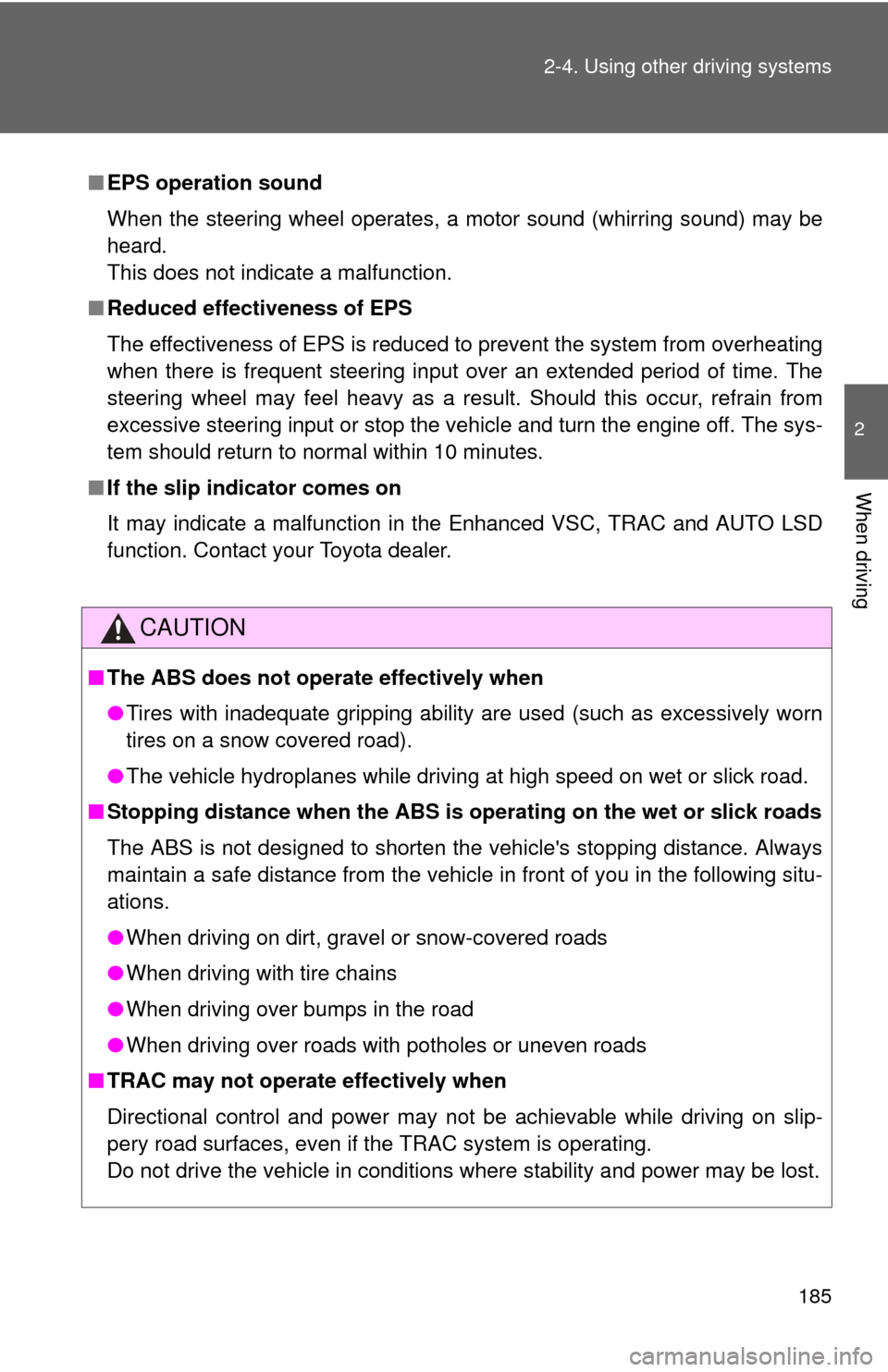2010 TOYOTA RAV4 tires
[x] Cancel search: tiresPage 4 of 513

TABLE OF CONTENTSIndex
4
Security and system setup ................................ 289
Using the phone book ........ 292
3-4. Using the interior lights Interior lights list ................. 300
• Personal/interior light main switch ...................... 301
• Personal/interior lights...... 301
• Interior light ...................... 302
• Luggage compartment light .................................. 302
3-5. Using the storage features List of storage features....... 304
• Glove box ......................... 305
• Console box ..................... 306
• Overhead console ............ 307
• Cup holders ...................... 308
• Bottle holders ................... 309
• Auxiliary box ..................... 311
3-6. Other interior features Sun visors .......................... 312
Vanity mirrors ..................... 313
Clock .................................. 314
Power outlets ..................... 315
Seat heaters ....................... 318
Armrest............................... 320
Coat hooks ......................... 321
Floor mat ............................ 322
Luggage compartment features ............................ 323 4-1. Maintenance and care
Cleaning and protecting the vehicle exterior ........... 330
Cleaning and protecting the vehicle interior ............ 333
4-2. Maintenance Maintenance requirements .................... 336
General maintenance ......... 338
Emission inspection and maintenance (I/M)
programs .......................... 341
4-3. Do-it-yourself maintenance Do-it-yourself service precautions ....................... 342
Hood ................................... 346
Positioning a floor jack........ 348
Engine compartment .......... 350
Tires.................................... 365
Tire inflation pressure ......... 372
Wheels................................ 376
Air conditioning filter ........... 378
Key battery ......................... 380
Checking and replacing fuses ................................. 384
Light bulbs .......................... 396
4Maintenance and care
Page 5 of 513

1
2
3
4
5
6
7
5
5-1. Essential informationEmergency flashers ............ 406
If your vehicle needs to be towed ........................... 407
If you think something is wrong ............................ 414
Fuel pump shut off system .............................. 415
Event data recorder ............ 416
5-2. Steps to take in an emergency
If a warning light turns on or a warning buzzer
sounds... .......................... 418
If you have a flat tire (vehicles with standard
tires) .................................. 430
If you have a flat tire (vehicles with run-flat
tires) .................................. 447
If the engine will not start .... 448
If the shift lever cannot be shifted from P.................... 449
If you lose your keys ........... 450
If the electronic key does not operate properly.......... 451
If the battery is discharged ........................ 453
If your vehicle overheats ..... 456
If the vehicle becomes stuck ................................. 458
If your vehicle has to be stopped in an
emergency ........................ 459 6-1. Specifications
Maintenance data (fuel, oil level, etc.) ........... 462
Fuel information.................. 474
Tire information .................. 477
6-2. Customization Customizable features........ 488
6-3. Initialization Items to initialize ................. 491
Reporting safety defects for U.S. owners ................ 494
Seat belt instructions for Canadian owners
(in French) ........................ 495
Abbreviation list ......................... 498
Alphabetical index ..................... 500
What to do if... ........................... 509
5When trouble arises6Vehicle specifications
7For owners
Index
Page 7 of 513

7
Tires
●Rotation
● Replacement
● Inflation pressure
● Information
P. 365
P. 430
P. 472
P. 477
Back door P. 46
Rear turn signal lights P. 153
: If equippedStop/tail and rear side
marker lights
P. 165
Rear
window
wiper
P. 171
License plate lights P. 165
Side doors P. 42
Rear
window
defogger
P. 233
License
plate light
P. 165
With spare tire Spare tire
P. 430
Fuel filler door P. 88
Roof luggage carrier
P. 198
Page 135 of 513

135
2-1. Driving procedures
2
When driving
Starting on a steep uphill
Firmly set the parking brake and shift the shift lever to D.
Gently depress the accelerator pedal.
Release the parking brake.
■Driving in the rain
●Drive carefully when it is raining, because visibility will be reduced, the
windows may become fogged-up, and the road will be slippery.
● Drive carefully when it starts to rain, because the road surface will be
especially slippery.
● Refrain from high speeds when driving on an expressway in the rain,
because there may be a layer of water between the tires and the road
surface, preventing the steering and brakes from operating properly.
■ Breaking in your new Toyota
To extend the life of the vehicle, the following precautions are recommended
to observe:
●For the first 200 miles (300 km):
Avoid sudden stops.
● For the first 500 miles (800 km):
Do not tow a trailer.
● For the first 1000 miles (1600 km):
• Do not drive at extremely high speeds.
• Avoid sudden acceleration.
• Do not drive continuously in the low gears.
• Do not drive at a constant speed for extended periods.
■ Drum-in-disc type parking brake system
Your vehicle has a drum-in-disc type parking brake system.
This type of brake system needs bedding-down of the brake shoes periodi-
cally or whenever the parking brake shoes and/or drums are replaced.
Have your Toyota dealer perform the bedding-down.
STEP 1
STEP 2
STEP 3
Page 138 of 513

138 2-1. Driving procedures
CAUTION
●Do not drive in excess of the speed limit. Even if the legal speed limit per-
mits it, do not drive over 85 mph (140 km/h) unless your vehicle has high-
speed capability tires. Driving over 85 mph (140 km/h) may result in tire
failure, loss of control and possible injury. Be sure to consult a tire dealer
to determine whether the tires on your vehicle are high-speed capability
tires or not before driving at such speeds.
■ When driving on slippery road surfaces
●Sudden braking, acceleration and steering may cause tire slippage and
reduce your ability to control the vehicle, resulting in an accident.
● Sudden changes in engine speed, such as engine braking caused by up-
shifting or down-shifting, may cause the vehicle to skid, resulting in an
accident.
● After driving through a puddle, lightly depress the brake pedal to make
sure that the brakes are functioning properly. Wet brake pads may prevent
the brakes from functioning properly. If the brakes on only one side are wet
and not functioning properly, steering control may be affected, resulting in
an accident.
■ When shifting the shift lever
Be careful not to shift the shift lever with the accelerator pedal depressed.
This may lead to unexpected rapid acceleration of the vehicle that may
cause an accident and result in death or serious injury.
■ When the vehicle is stopped
●Do not race the engine.
If the vehicle is in any gear other than P or N, the vehicle may accelerate
suddenly and unexpectedly, and may cause an accident.
● Do not leave the vehicle with the engine running for a long time.
If such a situation cannot be avoided, park the vehicle in an open space
and check that exhaust fumes do not enter the vehicle interior.
● In order to prevent accidents due to the vehicle rolling away, always keep
depressing the brake pedal while the engine is running, and apply the
parking brake as necessary.
Page 140 of 513

140 2-1. Driving procedures
CAUTION
●The exhaust should be checked occasionally. If there is a hole or crack
caused by corrosion, damage to a joint or abnormal exhaust noise, be
sure to have the vehicle inspected and repaired by your Toyota dealer.
Failure to do so may allow exhaust gases to enter the vehicle, resulting in
death or a serious health hazard.
■ When taking a nap in the vehicle
Always turn the engine off. Otherwise, you may accidentally move the shift
lever or depress the accelerator pedal, which could cause an accident or fire
due to engine overheating. Additionally, if the vehicle is parked in a poorly
ventilated area, exhaust gases may collect and enter the vehicle, leadin\
g to
death or a serious health hazard.
■ When braking the vehicle
●When the brakes are wet, drive more cautiously.
Braking distance increases when the brakes are wet, and may cause one
side of the vehicle to brake differently than the other side. Also the parking
brake may not securely hold the vehicle.
● If the power brake assist function does not operate, do not follow other
vehicles closely and avoid downhills or sharp turns that require braking.
In this case, braking is still possible, but it will require more force on the
pedal than usual. Braking distance may also increase.
● Do not pump the brake pedal if the engine stalls.
Each push on the brake pedal uses up the reserve for the power-assisted
brakes.
● The brake system consists of 2 individual hydraulic systems: If one of the
systems fails, the other will still operate. In this case, the brake pedal
should be depressed more firmly than usual and braking distance
becomes longer.
Do not drive your vehicle with only a single brake system. Have your
brakes fixed immediately.
■ If the vehicle becomes stu ck or bogged (4WD models)
Do not spin the wheels recklessly when any of the tires is up in the air, or
stuck in sand or mud etc. This may damage the drive system components or
propel the vehicle forward (or in another direction) and cause an accident.
Page 185 of 513

185
2-4. Using other
driving systems
2
When driving
■EPS operation sound
When the steering wheel operates, a motor sound (whirring sound) may be
heard.
This does not indicate a malfunction.
■ Reduced effectiveness of EPS
The effectiveness of EPS is reduced to prevent the system from overheating
when there is frequent steering input over an extended period of time. The
steering wheel may feel heavy as a result. Should this occur, refrain from
excessive steering input or stop the vehicle and turn the engine off. The sys-
tem should return to normal within 10 minutes.
■ If the slip indicator comes on
It may indicate a malfunction in the Enhanced VSC, TRAC and AUTO LSD
function. Contact your Toyota dealer.
CAUTION
■The ABS does not opera te effectively when
● Tires with inadequate gripping ability are used (such as excessively worn
tires on a snow covered road).
● The vehicle hydroplanes while driving at high speed on wet or slick road.
■ Stopping distance when the ABS is ope rating on the wet or slick roads
The ABS is not designed to shorten the vehicle's stopping distance. Always
maintain a safe distance from the vehicle in front of you in the following situ-
ations.
● When driving on dirt, gravel or snow-covered roads
● When driving with tire chains
● When driving over bumps in the road
● When driving over roads with potholes or uneven roads
■ TRAC may not operate effectively when
Directional control and power may not be achievable while driving on slip-
pery road surfaces, even if the TRAC system is operating.
Do not drive the vehicle in conditions where stability and power may be lost.
Page 186 of 513

186 2-4. Using other driving systems
CAUTION
■When the Enhanced VSC is activated
The slip indicator flashes and a warning buzzer sounds. Always drive care-
fully. Reckless driving may cause an accident. Exercise particular care when
the indicator light flashes and a buzzer sounds.
■ When TRAC and Enhanced VSC are off
Be especially careful and drive at a speed appropriate to the road condi-
tions. As these are systems to ensure vehicle stability and driving force, do
not turn off TRAC and Enhanced VSC unless necessary.
■ Replacing tires
Make sure that all tires are of the same size, brand, tread pattern and total
load capacity. In addition, make sure that the tires are inflated to the appro-
priate tire pressure level.
The ABS and Enhanced VSC systems will not function correctly if different
tires are fitted on the vehicle.
Contact your Toyota dealer for further information when replacing tires or
wheels.
■ Handling of tires and suspension
Using tires with any kind of problem or modifying the suspension will affect
the driving assist systems, and may cause the system to malfunction.